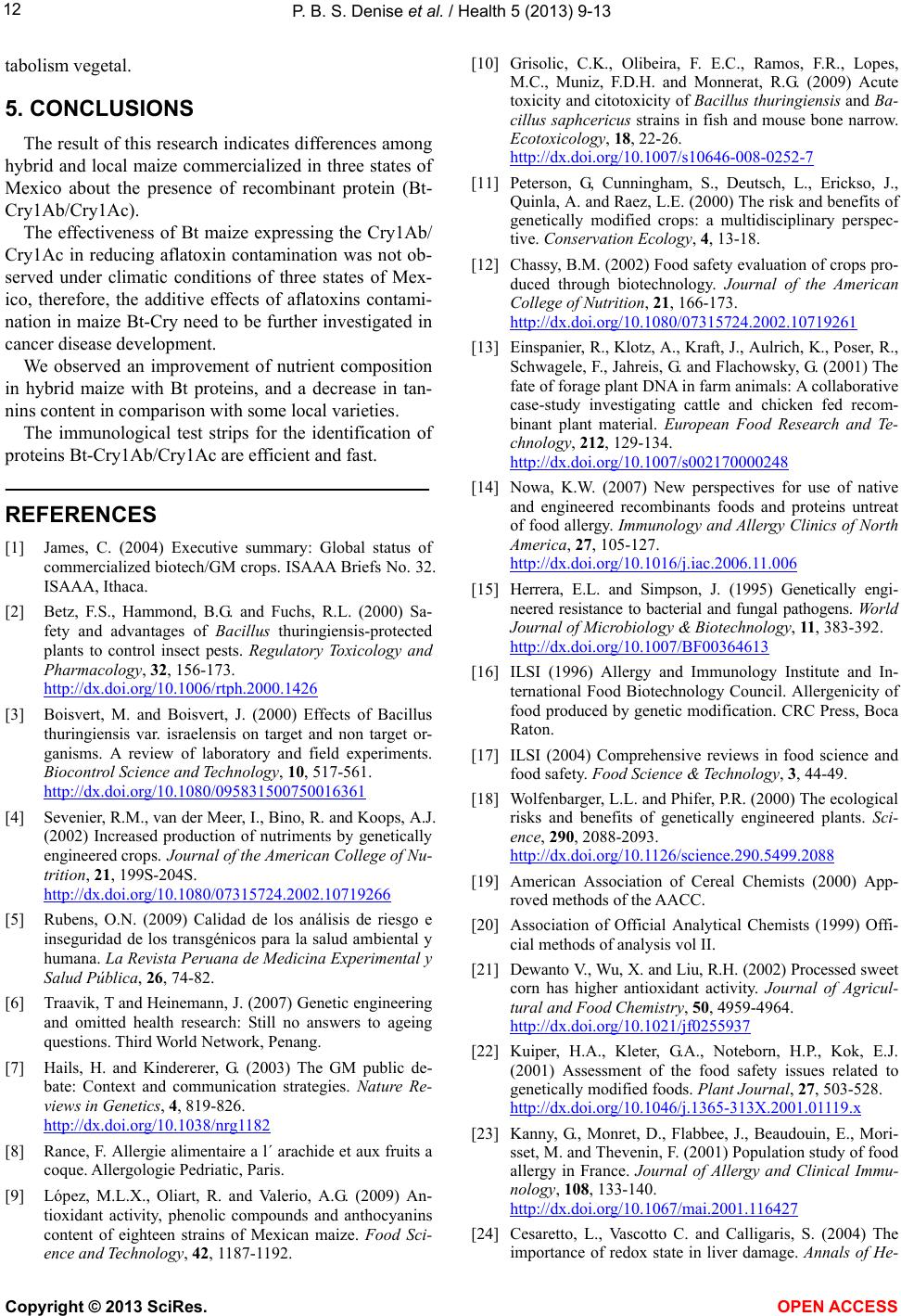
P. B. S. Denise et al. / Health 5 (2013) 9-13
12
tabolism vegetal.
5. CONCLUSIONS
The result of this research indicates differences among
hybrid and local maize commercialized in three states of
Mexico about the presence of recombinant protein (Bt-
Cry1Ab/Cry1Ac).
The effectiveness of Bt maize expressing the Cry1Ab/
Cry1Ac in reducing aflatoxin contamination was not ob-
served under climatic conditions of three states of Mex-
ico, therefore, the additive effects of aflatoxins contami-
nation in maize Bt-Cry need to be further investigated in
cancer disease development.
We observed an improvement of nutrient composition
in hybrid maize with Bt proteins, and a decrease in tan-
nins content in comparison with some local varieties.
The immunological test strips for the identification of
proteins Bt-Cry1Ab/Cry1Ac are efficient and fast.
REFERENCES
[1] James, C. (2004) Executive summary: Global status of
commercialized biotech/GM crops. ISAAA Briefs No. 32.
ISAAA, Ithaca.
[2] Betz, F.S., Hammond, B.G. and Fuchs, R.L. (2000) Sa-
fety and advantages of Bacillus thuringiensis-protected
plants to control insect pests. Regulatory Toxicology and
Pharmacology, 32, 156-173.
http://dx.doi.org/10.1006/rtph.2000.1426
[3] Boisvert, M. and Boisvert, J. (2000) Effects of Bacillus
thuringiensis var. israelensis on target and non target or-
ganisms. A review of laboratory and field experiments.
Biocontrol Science and Technology, 10, 517-561.
http://dx.doi.org/10.1080/095831500750016361
[4] Sevenier, R.M., van der Meer, I., Bino, R. and Koops, A.J.
(2002) Increased production of nutriments by genetically
engineered crops. Journal of the American College of Nu-
trition, 21, 199S-204S.
http://dx.doi.org/10.1080/07315724.2002.10719266
[5] Rubens, O.N. (2009) Calidad de los análisis de riesgo e
inseguridad de los transgénicos para la salud ambiental y
humana. La Revista Peruana de Medicina Experimental y
Salud Pública, 26, 74-82.
[6] Traavik, T and Heinemann, J. (2007) Genetic engineering
and omitted health research: Still no answers to ageing
questions. Third World Network, Penang.
[7] Hails, H. and Kindererer, G. (2003) The GM public de-
bate: Context and communication strategies. Nature Re-
views in Genetics, 4, 819-826.
http://dx.doi.org/10.1038/nrg1182
[8] Rance, F. Allergie alimentaire a l´ arachide et aux fruits a
coque. Allergologie Pedriatic, Paris.
[9] López, M.L.X., Oliart, R. and Valerio, A.G. (2009) An-
tioxidant activity, phenolic compounds and anthocyanins
content of eighteen strains of Mexican maize. Food Sci-
ence and Technology, 42, 1187-1192.
[10] Grisolic, C.K., Olibeira, F. E.C., Ramos, F.R., Lopes,
M.C., Muniz, F.D.H. and Monnerat, R.G. (2009) Acute
toxicity and citotoxicity of Bacillus thuringiensis and Ba-
cillus saphcericus strains in fish and mouse bone narrow.
Ecotoxicology, 18, 22-26.
http://dx.doi.org/10.1007/s10646-008-0252-7
[11] Peterson, G, Cunningham, S., Deutsch, L., Erickso, J.,
Quinla, A. and Raez, L.E. (2000) The risk and benefits of
genetically modified crops: a multidisciplinary perspec-
tive. Conservation Ecology, 4, 13-18.
[12] Chassy, B.M. (2002) Food safety evaluation of crops pro-
duced through biotechnology. Journal of the American
College of Nutrition, 21, 166-173.
http://dx.doi.org/10.1080/07315724.2002.10719261
[13] Einspanier, R., Klotz, A., Kraft, J., Aulrich, K., Poser, R.,
Schwagele, F., Jahreis, G. and Flachowsky, G. (2001) The
fate of forage plant DNA in farm animals: A collaborative
case-study investigating cattle and chicken fed recom-
binant plant material. European Food Research and Te-
chnology, 212, 129-134.
http://dx.doi.org/10.1007/s002170000248
[14] Nowa, K.W. (2007) New perspectives for use of native
and engineered recombinants foods and proteins untreat
of food allergy. Immunology and Allergy Clinics of North
America, 27, 105-127.
http://dx.doi.org/10.1016/j.iac.2006.11.006
[15] Herrera, E.L. and Simpson, J. (1995) Genetically engi-
neered resistance to bacterial and fungal pathogens. World
Journal of Microbiology & Biotechnology, 11, 383-392.
http://dx.doi.org/10.1007/BF00364613
[16] ILSI (1996) Allergy and Immunology Institute and In-
ternational Food Biotechnology Council. Allergenicity of
food produced by genetic modification. CRC Press, Boca
Raton.
[17] ILSI (2004) Comprehensive reviews in food science and
food safety. Food Science & Technology, 3, 44-49.
[18] Wolfenbarger, L.L. and Phifer, P.R. (2000) The ecological
risks and benefits of genetically engineered plants. Sci-
ence, 290, 2088-2093.
http://dx.doi.org/10.1126/science.290.5499.2088
[19] American Association of Cereal Chemists (2000) App-
roved methods of the AACC.
[20] Association of Official Analytical Chemists (1999) Offi-
cial methods of analysis vol II.
[21] Dewanto V., Wu, X. and Liu, R.H. (2002) Processed sweet
corn has higher antioxidant activity. Journal of Agricul-
tural and Food Chemistry, 50, 4959-4964.
http://dx.doi.org/10.1021/jf0255937
[22] Kuiper, H.A., Kleter, G.A., Noteborn, H.P., Kok, E.J.
(2001) Assessment of the food safety issues related to
genetically modified foods. Plant Journal, 27, 503-528.
http://dx.doi.org/10.1046/j.1365-313X.2001.01119.x
[23] Kanny, G., Monret, D., Flabbee, J., Beaudouin, E., Mori-
sset, M. and Thevenin, F. (2001) Population study of food
allergy in France. Journal of Allergy and Clinical Immu-
nology, 108, 133-140.
http://dx.doi.org/10.1067/mai.2001.116427
[24] Cesaretto, L., Vascotto C. and Calligaris, S. (2004) The
importance of redox state in liver damage. Annals of He-
Copyright © 2013 SciRes. OPEN ACCESS